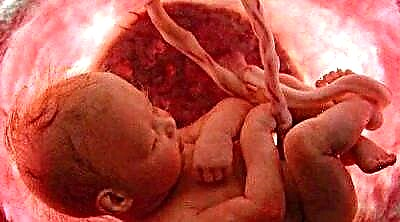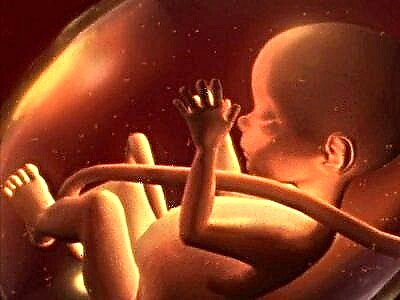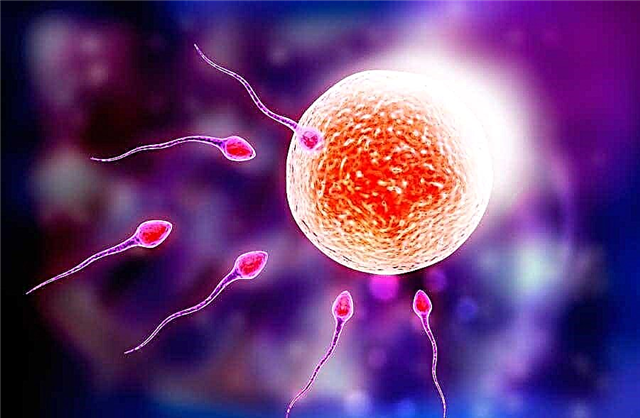
The entanglement of the fetus with the umbilical cord refers to such pathologies that a pregnant woman usually does not know about. The fact becomes obvious only during the passage of the next ultrasound scan of the baby or during CTG, if the entanglement already has negative consequences. Why this happens and what the consequences may be, we will tell in this material.

What it is?
Umbilical cord entanglement is a pregnancy pathology in which the umbilical cord forms a loop around the body, limbs or neck of the fetus growing in the mother's womb. The consequences of entanglement can be rather sad, and therefore a pregnant woman should understand the essence of the pathological process as best as possible in order to know how to act.
The umbilical cord is an elastic cord, inside which the vessels are located. Two arteries and one vein fully meet the vital needs of the baby. The arteries remove the child's waste products (urea, creatinine, carbon dioxide) into the placenta, and the vein supplies the baby with fresh maternal blood saturated with oxygen, vitamins, water and minerals. Thus, the baby eats, breathes and removes metabolic products.
One end of the umbilical cord is attached to the placenta, usually to its central part, and the other to the anterior abdominal wall of the child. The length of the umbilical cord normally ranges from 50 to 70 centimeters. A longer cord gives the child more freedom of movement, while at the same time creating a more real threat of entanglement.

An umbilical cord shorter than 40 centimeters is also dangerous - it limits the motor activity of the fetus, often disrupts the blood flow through its vessels, and also creates the risk of placental abruption ahead of time during childbirth, because the baby, when passing the birth canal, will strongly pull the umbilical cord "child's seat".
The state of the cord entanglement is registered, according to medical statistics, for every 5 women in an "interesting position". An entanglement can happen at any stage of pregnancy, but the greatest danger is the second trimester - the baby is actively moving, turning over. If by the third trimester he does not manage to unravel, then the entanglement will most likely remain until the very birth, because there is very little room for movement in the uterus in the last third of the gestation period.
Most often, doctors diagnose an entanglement around the baby's neck. In this case, complications from the fact of entanglement occur in about 10% of cases. If the umbilical cord is short relative to the norm, then the entanglement is less dangerous than with a long one (over 70 cm). Excessive excess of the length of the umbilical cord creates the danger of not only double or triple entanglement, but also the occurrence of knots, which, when the cord is pulled, can tighten. Then the child will be in danger of suffocation due to acute oxygen deficiency and intrauterine death.
Causes
Very often, the entanglement of the baby with the umbilical cord occurs with the developing fetal hypoxia at an early stage. When the child begins to lack oxygen, he increases his physical activity, trying to get more of the necessary gas. Chaotic movements in the womb become the main reason for the formation of a loop of the umbilical cord around the neck, leg or body of the baby.
Quite often, doctors are faced with an "inherited" entanglement, when a daughter, having become pregnant, completely repeats the maternal scenario. With polyhydramnios, entanglement is also not uncommon. A large amount of amniotic fluid creates additional space for movement and somersaults, as a result of which the baby is simply entangled in the umbilical cord. And with low water, experts say, the umbilical cord itself can create loops, and, deprived of the opportunity to dodge the force of a small space for movement, the baby is entwined.
Any violation of the course of pregnancy, which may lead to hypoxia, is dangerous in terms of the likelihood of entanglement. Often, pathology occurs due to chronic anemia in the mother, with placenta previa, with placental abruption.


Very often, the pathology is diagnosed in pregnant women who work in hazardous industries, have contact with harmful substances - varnishes and solvents, paints, toxins, nitrates, as well as expectant mothers who live in large cities with an unfavorable environmental situation. Not the last place among the reasons is given to bad habits while carrying a baby - smoking, alcohol, drugs increase the likelihood of pathology development tenfold.
Any condition in which more adrenaline is produced in the body of the expectant mother is dangerous - the more this hormone, the more active the baby, and therefore the higher the likelihood of entanglement. These situations include stress, anxiety, emotional swings, fear and even great joy.
Insufficient nutrition of a pregnant woman while carrying crumbs also increases the likelihood of entanglement.


Symptoms and Diagnosis
The woman herself may not feel the umbilical cord entanglement of the baby, but at a certain stage, when the baby is already suffering, she will definitely notice a change in his motor activity. At the initial stages of hypoxia, children move actively, painfully, with neglected and chronic oxygen deficiency, on the contrary, the activity decreases.
For doctors, it is not so much the very fact of detecting the loop of the umbilical cord that is important, but the characteristic of the pathology, which includes the determination of the number of loops. The prognosis and the choice of the method of delivery depends on what the entanglement will be.
On this basis, a single entanglement is distinguished, in which the umbilical cord is wrapped once around some part of the baby's body, or multiple (two, three, four, etc.), in which the number of loops is more than one.


If more than one loops are found, then the type of pathology is determined:
- insulated entanglement - with it, the loops are located around one part of the body;
- combined - with it, the loops are located around different parts of the body, for example, around the neck and around the abdomen.
More favorable forecasts have a loose entanglement - with it there is no compression of the anatomical part of the fetal body, the loop exists, but does not give the baby any significant inconvenience. Less favorable cases of tight entanglement, which occurs in 10% of cases. With it, the blood vessels of the umbilical cord may be squeezed, which with a high degree of probability will lead to suffocation and acute hypoxia, the death of the child.

If the gestation period does not exceed 30-32 weeks, then there is a high probability that the baby will be able to untangle himself, because he is not too limited in his movements yet, the place in the uterus allows him to roll over. After 32 weeks, unraveling on its own is unlikely.
An ultrasound doctor can detect the problem, starting from 13-14 weeks of pregnancy. It is by this time that the formation of the placenta and the umbilical cord usually ends. However, at this time, you should not be afraid of the diagnosis - the baby is so small that it is not difficult for him to unravel, get confused again and again free himself from the loops.
UZDG - ultrasound scanning with color dopplerometry allows to determine the number of loops. This allows not only to calculate the multiplicity, but also to recognize possible violations in the state of the crumb. Probable hypoxia can be indicated by disturbances in blood flow in the uteroplacental vessels, as well as a slowdown or acceleration of the baby's heart rate.

Treatment
It is impossible to cure the entanglement. There is not a single obstetric technique, not a single medication that could help cope with this task. Doctors recommend that a woman calm down, stop being nervous and visit antenatal clinics more often. From the 28th week of pregnancy, a woman may be recommended a weekly CTG, as well as an ultrasound scan with a Doppler once every two weeks. The tactics of waiting and observing at any time can be interrupted if violations of the baby's condition are noticed.
In this case, the woman is advised to be hospitalized; insisting on home treatment is pointless and dangerous. A woman with a diagnosed entanglement is recommended to have a full and balanced diet, taking vitamins that will compensate for the nutritional deficiency in the baby's body. The absence of stress in the expectant mother will help to avoid tightening the loop; herbal light sedatives are recommended to calm her.
A woman is advised to breathe more fresh air, take oxygen cocktails, not be in smoky rooms, and avoid any contact with harmful substances.


If there is an opportunity to live outside the city in the fresh air, you should definitely use it. Quite often, drugs are recommended that help improve blood circulation in the mother-placenta-fetus system (Curantil or Actovegin).
How to give birth?
If the entanglement is loose and single, the woman is usually allowed to give birth naturally. True, control over such a woman in labor will be increased: every half hour the doctor will check the readings of the CTG sensors to make sure that everything is fine with the baby. When signs of a violation of the baby's well-being appear, an emergency cesarean section is performed.
Childbirth with entanglement requires high qualifications and extensive experience from obstetricians. The noose from the neck, if it is located there, is removed immediately as soon as the head is born, delay is unacceptable. A woman should pay more attention to the choice of a doctor and obstetric institution. The birth certificate, which she receives when registering maternity leave, allows her to choose any maternity hospital or perinatal center, based on personal experience or feedback from doctors and other women in labor.
With repeated entanglement and its tight type, natural childbirth is not allowed. This pathology is an unambiguous indication for a cesarean section. The baby in the womb and without the process of childbirth experiences a lack of oxygen, and it is not known what the consequences of hypoxia will be in the future. In childbirth, such a pathology can lead to the death of the baby.

Early hospitalization will help to prevent spontaneous childbirth - usually at 37 weeks, a woman is referred to the hospital, where she undergoes a planned cesarean section. If labor begins before this date, the operation will be done urgently.
Prevention
To prevent an unpleasant pathology of the umbilical cord, from the first weeks of pregnancy, you should make sure that the expectant mother does not come into contact with harmful substances, eat well and walk a lot. If her work involves night shifts, a change in working conditions is required. To prevent anemia, you should take iron supplements and take all the required tests in the antenatal clinic on time.


Special medical gymnastics allows you to avoid entanglement. It is based on a combination of light and easy exercise with breathing exercises, which, among other things, will help the baby get more oxygen from the mother's blood. Obstetric gymnastics will also be useful when entwined in the pelvic or transverse presentation.
Psychosomatics of pathology
Psychosomatics experts are sure that the cord entanglement has its deepest causes and consequences, the knowledge of which will help a woman avoid difficulties in carrying and raising a child. It is believed that the very fact of intrauterine discomfort that a child experiences with such a pregnancy pathology cannot but affect his health and life in the future.
Children, who in the womb experienced entanglement around their necks, for reasons incomprehensible at first glance, at a more conscious age, begin to refuse to wear scarves, ties, turtleneck sweaters. And in stressful situations, such children may experience bouts of psychological suffocation, when inhalation and exit becomes difficult due to the distant "memory" of the subconscious.
Psychosomatics identifies several reasons why a pregnant woman may develop an umbilical cord entanglement. Among them, the main place is occupied by the mother's perception of her child.

If a woman doubts whether she needs a baby, if the pregnancy was unplanned and unwanted, but for some reason the pregnant woman did not dare to have an abortion, then the entanglement occurs due to a violation of the delicate spiritual connection between the mother and the fetus.
The other extreme is excessive love, which is often said to "choke". Therefore, pathology often occurs in couples who have been waiting for pregnancy for a long time, and now the expectant mother is ready for anything, if only the baby is good.
Also, entanglement can develop in a woman who is unsure of her capabilities, worries about a lack of money or lack of a husband. In addition, the pathology is more susceptible to women who, being girls themselves, were subjected to violence, abuse, or had the experience of drowning.

Esoterics and omens
It is believed that a child born with an entanglement will live a difficult and difficult life, many trials will fall on his lot. To avoid this, since ancient times there has been a rite of reprimanding such babies. In the first year of his life after accepting the Sacrament of Baptism, mothers read over the child "Theotokos, Virgin, rejoice." Boys are scolded on "men's" days - Monday, Tuesday, Thursday. Girls - on "women" (Friday, Wednesday, Saturday). You cannot tell a child off on Sunday.
There is a sign that pregnant women should not knit and sew, so as not to tie "knots" to the child, but in practice there is no evidence of harm to needlework. On the contrary, doctors believe that quiet handicraft activities reduce adrenaline levels and save the baby from entanglement.

For hypoxia and cord entanglement, see the next video.



